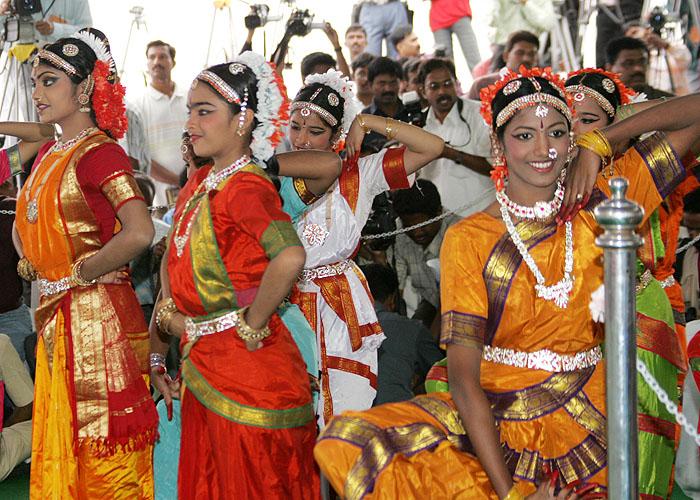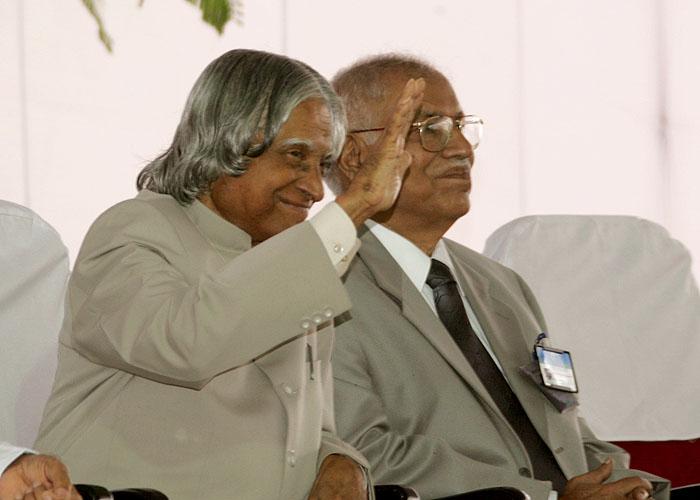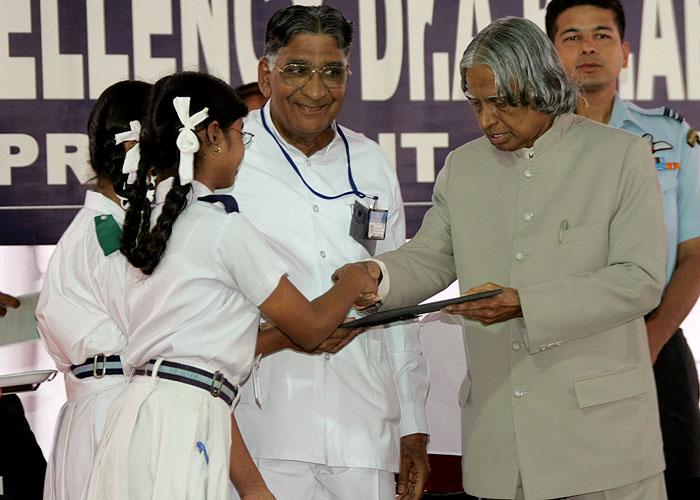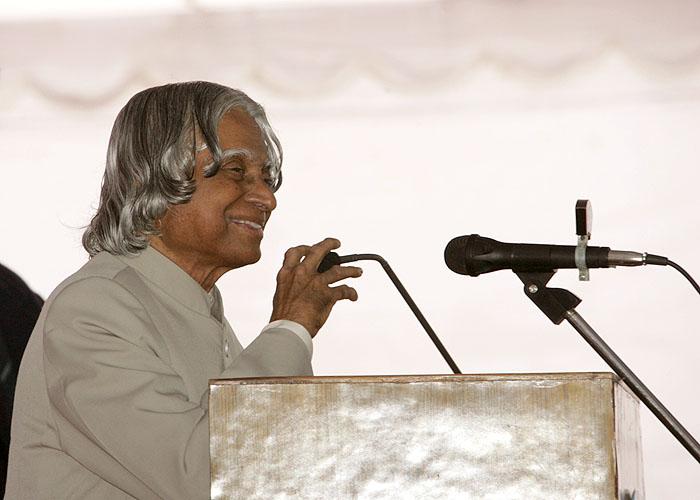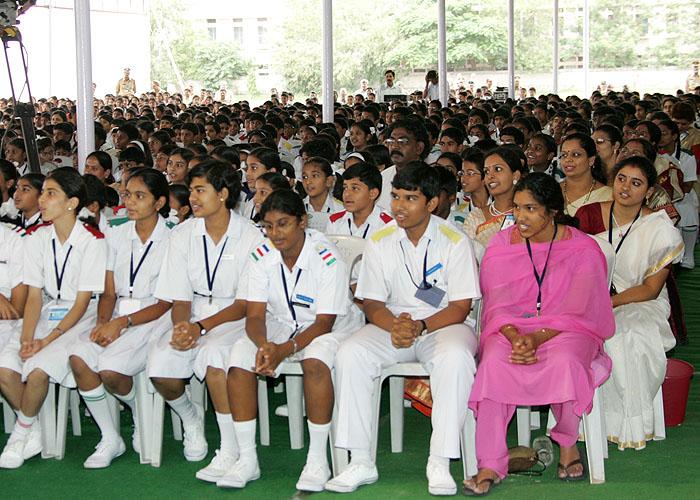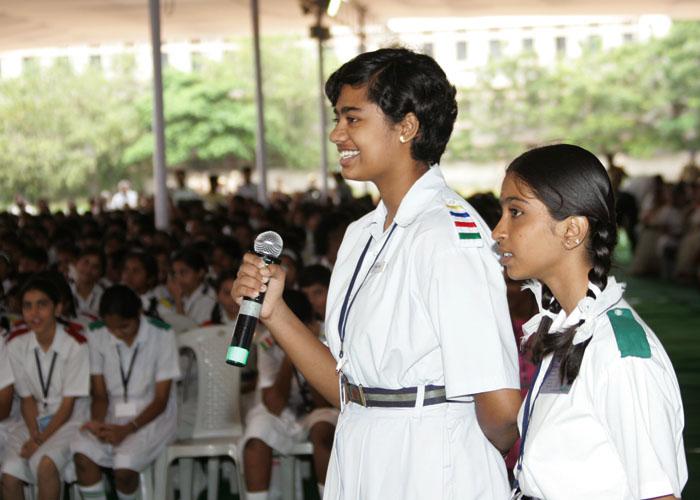Address and Interaction With the Students of Jubilee Hills Public School and Other Hyderabad Schools, Hyderabad
Hyderabad : 05-08-2005
Vision for the Nation
I am delighted to be here in this beautiful environment and interact with the students of Hyderabad schools in the Jubilee Hills Public School campus. My greetings to the principal, teachers, students and parents. When I am with you, I would like to discuss on the topic "Vision for the Nation".
CARTOSAT and HAMSAT - Twin Satellite Mission
It was a beautiful experience for me and the nation, when the 6th in the successful series of Polar Satellite Launch Vehicle (PSLV) taking off with two spacecrafts from Satish Dhawan Space Centre, Sriharikota on 5th May 2005. One day, some of you may opt for space technology and high-technology work. Hence, I would like to share this experience.
CARTOSAT-1 and its features: When satellite CARTOSAT-I was injected in the polar orbit of 618 km., it has become world class earth mapper. The mission of PSLV from take off to injection of the satellites to the required orbit was achieved within 18 minutes with precision. I congratulated the ISRO team. Let me talk to you, what the CARTOSAT will provide to the nation. CARTOSAT is the eleventh satellite in the Indian remote sensing satellite series, it has twin camera systems that give together stereoscopic imaging capability along the track providing 2.5 mtr spatial resolution and swath (width) of 30 km. The satellite has a control capability to revisit any part of our country within 5 days and transmit data in X-Band mode. A unique feature of this satellite is that it has got onboard compression and encryption with RF system of phased array antennas with 64 elements. The CARTOSAT-I with its stereoscopic imaging capability along the track will provide the country 3-D digital mapping capability.
CARTOSAT-1 will find applications related to land, water and environment management and to provide disaster management support. It will enable generation of large scale base maps, thematic maps, national level digital elevation model, digital terrain model, contour interval mapping to the extent of around 10 meters. The data from CARTOSAT-1 in conjunction with other IRS Satellite data will be useful in applications such as mapping of settlements, urban utility mapping, delineation of water shed. Digital terrain model with improved accuracies will find applications in inter-river basin studies pertaining to interlinking of rivers and urban and rural infrastructure development such as rural road connectivity and alignment of national railway lines.
Another important application, would be in the area of disaster management, to determine the extent of damage and the type of emergency assistance needed. This has been made possible by our Space Scientists by using the high resolution stereoscopic imagery from CARTOSAT-1. During my visit to Kerala last week, I showed a CARTOSAT-1 image of Kerala coast in relation to the development of inland water way from Thiruvananthapuram to Kasargod. This successful mission of CARTOSAT-1 has definitely provided leadership to our country in space based earth mapping technology in the world.
HAMSAT : HAMSAT is a micro satellite for providing satellite based Amateur Radio Services to the national as well as the international community of Amateur Radio Operators (HAMS). Launched as an auxiliary payload along with CARTOSAT-1, the 42.5 kg HAMSAT will meet the long felt need of the Amateur Radio Operators in the South Asian region who possess the required equipment and to operate in the UHF/VHF band based satellite radio communication. One of the transponders of HAMSAT has been developed indigenously involving Indian HAMs, with the expertise of ISRO and the experience of HAMSAT-INDIA. The second transponder has been developed by a Dutch Amateur Radio Operator and Graduate Engineering student at Higher Technical Institute, Venlo, The Netherlands. Similarly India?s student community in schools and colleges can build micro satellites in cooperation with ISRO scientists. I hope many of you are HAM operators or users.
These twin satellites have been launched a rocket system called Polar Satellite Launch Vehicle. Its take off weight around 300 hundred tonnes with overall height of nearly 44 meters. It is four stage rocket system when the CARTOSTAT and MICROSAT are injected the velocity imparted by the four rocket system about 7.6 km per second. Thousands of engineers work at VSSC and Satish Dhawan Space Centre for realizing launch vehicle. Similarly the satellite systems are developed such as communication satellite, remote sensing satellite and CARTOSAT satellite at ISRO satellite centre and space application centre.
Launch of EDUSAT
Dear Children I would like to recall the launching of geo-synchronous vehicle on 20th September 2004. It is a huge three stage controlled and guided rocket system weighing 400 tones. This world class rocket system has put a communication satellite called EDUSAT (Education satellite) in the geosynchronous orbit. This rocket has capability to inject a satellite of one thousand Kg in the orbit with the velocity of 10.2 kilometers per second. This means speed of the satellite is 36 times the speed of modern passenger jet aircraft. That means you will be surprised to know it will take less than five minutes to travel from Delhi to Chennai instead of two and half hours by a jet. Do you know what geosynchronous orbit is? Geosynchronous orbit refers to the path of the satellite around the earth at an altitude of 36,000 kilometers in equatorial plane with the same rotational velocity of earth. The satellite now beams the education programmes throughout the day and night.
Objective of EDUSAT
The prime objective of the EDUSAT programme is to provide support to education through low-cost ground segments and to reach the un-reached people of India to every nook and corner. The satellite is specially configured to have multiple beams covering different regions of India. This is a satellite operating in Ku band in 17 Giga hertz frequency band facilitating the use of small transmit/receive ground terminals. It provides communication coverage through five regional beams and a national beam.
This system will be primarily for school, college and higher level of education; however it will also support non-formal education. In the initial phase EDUSAT will cover about 100 to 200 classrooms per beam. The EDUSAT, when fully operational will have a capacity of 30 uplinks and about 5000 remote terminals per uplink. EDUSAT is expected to provide one-lakh fifty thousand ground terminals in its full capacity.
For example, suppose a mathematics teacher takes a class at Bhimavaram, Andhra Pradesh, it is beamed to EDUSAT satellite in real time and the students in the class rooms at Gurudaspur, Punjab will see the teacher and hear the lessons. Students from the various parts of the country -a village school in Bihar, a village in Orissa, North East, West Bengal, will also hear his/her teaching and can ask the questions in sequence. Hence a good teacher teaching anywhere in the country in any language can be heard, seen and interacted. Nowhere in the world an exclusive education satellite is in the orbit today, except India?s. Today, India has the capability of building any type of launch vehicle and type of spacecraft. This great scientific achievement has been made possible due to our great Indian space Scientists and partner institutions. Friends, we are witnessing how a space vision by Prof. Vikram Sarabhai has been transformed into reality leading to benefit to society. Prof. Vikram Sarabhai was indeed my role model when I started my professional career as rocket engineer. The country has now acquired capability to launch a lunar mission Chandrayan during 2007. When you grow up and you are in your 30s you might hear about manned mission to Mars. Now I would like to discuss how India achieve self-reliance in agriculture.
Evolution of First Green Revolution
I was a young boy in Rameswaram during the post independent period. At that time I vividly recall the village community eagerly awaiting for the wheat ship to reach the Madras port so that wheat can reach the village by road. This was the main feeding force for the country in those days. The country used to have hardly a week's reserve and any delay in the arrival of the ship would cause severe supply problems. This situation was prevalent till the early 60's. The Green Revolution Programme was launched by political visionary Shri C. Subramaniam and scientific visionary Dr. M.S. Swaminathan with the help of the scientists, entrepreneurs and the farmer community. In addition, what was needed was a good water management system, availability of high quality seeds, good storage facility and proper distribution mechanism. These facilities were provided by the Government through its various development schemes. This has led to intensive agriculture in the country which produced a substantial amount of food grains and liberated us from the situation of what is called "ship to mouth existence". As part of this first green revolution, the country has been able to produce 200 million tonnes of grains per year.
Second Green Revolution
Now the country has embarked upon the Second Green Revolution which will enable it to increase its productivity in the agricultural sector. The production of cereals needs to increase from the present 200 million tonnes to over 400 million tonnes by 2020 in view of population growth. But the requirement of land for the increasing population as well as for greater afforestation and environmental preservation activities would demand that the present 170 million hectares of arable land will have to be brought down to 100 million hectares by 2020. All our agricultural scientists and technologists have to work for doubling the productivity of the available land with lesser area and less water being available for cultivation. The type of technologies needed would be in the areas of biotechnology, proper training to the farmers, additional modern equipments for preservation and storage etc. The second green revolution is indeed graduating from grain production to food processing and marketing.
Friends, so far I have discussed two visions how they have been visualized in the field of space technology and food production. Since you will be completing your school studies and entering into various professional and other colleges, and university education, you have to remember all great achievement will possible only by a few visionaries and they will always be remembered in the scientific field and in the Indian history. Now let me ask you friends, each one of you pose a question to yourself "In my country what I will be remembered for?". This question may be a difficult question. If you answer after lot of thinking, definitely you will come up for your mission in you life or your goal in you life. I will definitely be very happy to receive your missions and goals and you can correspond with me through my website. Similarly, you should ask yourself the question "What I should be remembered for"? Can you think and tell me about this?
Now I would like to answer some of the questions asked by the students.
Question and Answer Session
1. Your Excellency Mr. President , Which part of your life would you consider more worthy to the nation - As a scientist or as the President of India.
- Annie Jerry, VI-A
Ans: As a scientist I was involved in the development of space launch vehicles, missiles and also preparing a road map for transforming India into a developed nation. Today, as President of India, I am marketing the concept so that our vision of developed India can be fulfilled.
2. Your Excellency Mr. President , Many scientists went to space and took up research in space. Why didn?t you go to space ?
- Krishna Teja, VI-C
Ans: I was developing launch vehicles which can put satellite into space.
3. Your Excellency Mr .President Sir, Please tell us about how a person should feel when he fails to achieve his aim?
- C. Sahithi, VII-B
Ans: When you do a mission you are bound to encounter some problem. When problem arise you should not allow problem to become your master. You should become the master of the problem, defeat the problem and succeed.
4. Your Excellency Mr. President, What advice would you give to the children who aren?t interested in academics ?
- A Sai Sreeshma, VIII-A
Ans: Every child is interested in academics. What we require is a committed teacher who can motivate the child by making the subject interesting. The child must be encouraged to use the creative abilities. In such a situation, the child will love academics. Also I must tell you it is necessary for every one of you to at least complete your education till class twelve after which you can take up vocational training programme suited to your aptitude and choice.
5. Your Excellency Mr. President, Who was your role model in your childhood?
- Rusheel, X
Ans: My elementary school teacher Shri Shivasubramania Iyer was my role model since he taught me how the bird flies so well that I was inspired to take up something to do with flight as my career and in the later part of my life I became a rocket engineer.
6. Your Excellency Mr. President Sir, do you think literacy is the solution for every problems in India, These days most of the crimes are committed by highly educated officials.
- Lisa, X
Ans: Literacy is a very important necessity for development and growth of the society. Recently when I went to Kerala I found that the literacy being high in the State has resulted in High Human Development Index. As per recent survey conducted by Transparency International India, Kerala has been adjudged as the least corrupt State. Apart from the formal education, there is a need to imbibe good value system among the students. If the good value systems are imbibed, the society is bound to be crime free.
7. Your Excellency sir, Is there any research or project you thought of doing but could not do due to becoming of President of India? If so, what is it?
- K. Divya, Senior Inter MPC
Ans: No. I had a Ph.D. student Father George working with me in Anna University. He continues to carry out his research under my guidance.
8. Your Excellency sir, Nanotechnology is the present development in our country. Does it have any ill effects?
- Pruthvi, Senior MPC
Ans: Every technology will have both good and bad effects. Mankind has to make use of the good effects only. They should find methods by which the ill-effects are made ineffective.
TEN POINT OATH
1. I will pursue my education or the work with dedication and I will excel in it.
2. From now onwards, I will teach at least 10 persons to read and write those who cannot read and write.
3. I will plant at least 10 saplings and shall ensure their growth through constant care.
4. I will visit rural and urban areas and permanently wean away at least 5 persons from addiction and gambling.
5. I will constantly endeavor to remove the pain of my suffering brethren.
6. I will not support any religious, caste or language differentiation.
7. I will be honest and endeavour to make a corruption free society.
8. I will work for becoming an enlightened citizen and make my family righteous.
9. I will always be a friend of the mentally and physically challenged and will work hard to make them feel normal, like the rest of us.
10. I will proudly celebrate the success of my country and my people.

